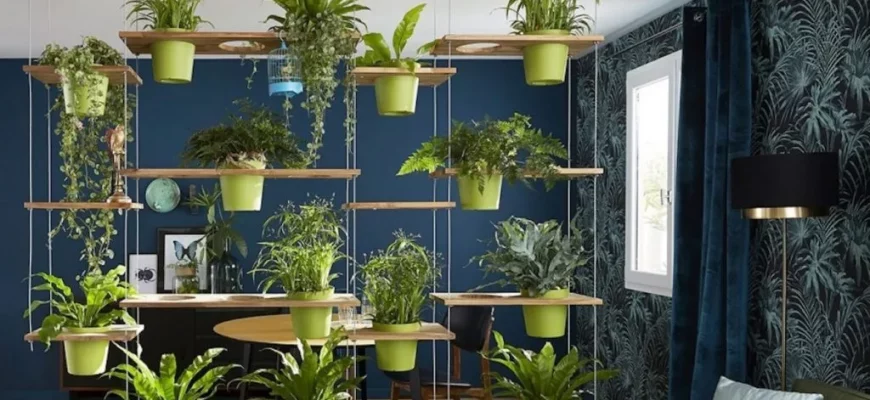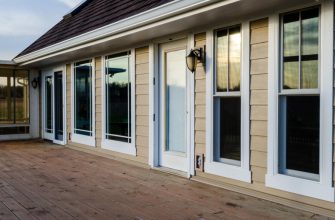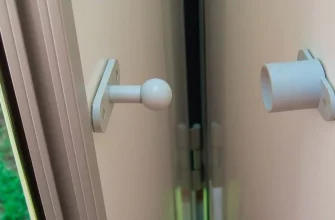Having plants indoors provides many benefits – they purify the air, add visual interest, and can even boost moods. But did you know that certain plants can also help absorb unwanted noise? It’s true! Some indoor plants are particularly effective at reducing echo and absorbing errant sounds thanks to their large, wide leaves and bushy foliage.
In this blog post, we’ll explore the concept of using plants to absorb noise, overview the key benefits, spotlight 10 top sound-absorbing varieties, explain how plants actually reduce noise levels, and provide tips for selecting and arranging plants for optimal acoustic impact.
So if you’re looking to make your home or office a little quieter and more peaceful, read on to learn all about sound-absorbing indoor plants!
- Understanding the Concept of Sound Absorbing Indoor Plants
- Overview of the Benefits of Using Sound Absorbing Indoor Plants
- Top 10 Sound Absorbing Indoor Plants
- Norfolk Island Pine
- Areca Palm
- Fiddle Leaf Fig
- Money Tree
- Peace Lily
- Strelitzia Nicolai (White Bird of Paradise)
- Ficus Lyrata (Fiddle Leaf Fig)
- Dracaenas
- Rhapis Excelsa (Lady Palm)
- Howeia Forsteriana (Kentia Palm)
- How Do Plants Reduce Indoor Noise Levels?
- Deflection of Sound Waves by Plants
- Trapping and Absorption of Sound by Plant Features
- Experiment and Evidence of Sound Reduction by Indoor Plants
- Conclusion
Understanding the Concept of Sound Absorbing Indoor Plants
The notion of using plants to absorb noise may seem surprising at first. After all, plants are living things, not acoustic panels! However, extensive research has shown that plants can in fact absorb, deflect, and muffle sounds quite effectively indoors.
Certain large-leafed green plants happen to have excellent acoustic properties that dampen echoes and reverberation. Their leaves, branches, and overall bushy shape help block, scatter, and absorb sound waves rather than reflecting them. This reduces the bothersome reverberation that can build up indoors and contribute to an unpleasant level of background noise.
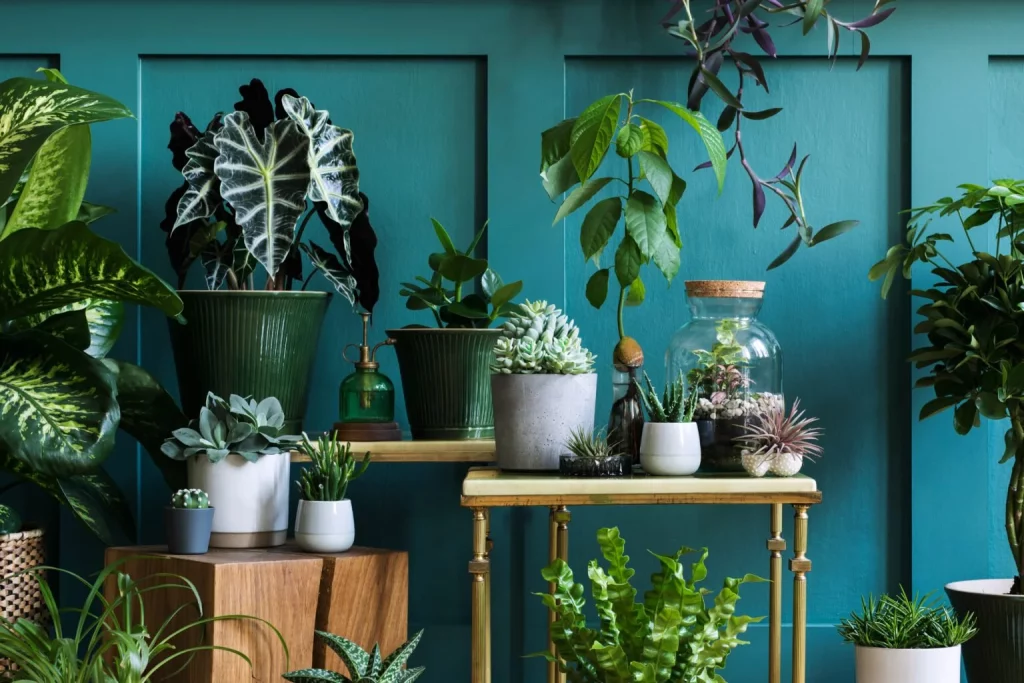
In addition, the soil, moss, and potting materials surrounding plant roots provide sound-diffusing density. The combined physical traits of leafy indoor plants allows them to soak up ambient noise like a natural sponge!
Using these noise-reducing plants to strategically dampen and absorb sound can make a significant difference in interior acoustic comfort. Rooms filled with sound-absorbing plants have a much more peaceful, relaxed ambiance.
Overview of the Benefits of Using Sound Absorbing Indoor Plants
There are many excellent reasons to use sound-absorbing houseplants to help reduce noise:
- They absorb echo, reverberation, and excess noise more attractively than traditional acoustic panels or foam.
- Plants purify the indoor air while absorbing sound, improving air quality.
- Their natural beauty enhances décor and visual appeal.
- Caring for houseplants boosts moods and can reduce stress.
- Strategically clustering noise-reducing plants in problem rooms helps dampen sound.
- They are an affordable and accessible acoustic solution for homeowners and renters.
- Plant “walls” can provide effective noise screening between rooms or zones.
- Mobile potted plants allow flexibility in positioning as needed.
With all these excellent benefits, it’s easy to see why using plants is such a popular acoustic strategy. The right selection of sound-absorbing varieties can make a home or office noticeably more peaceful and enjoyable.
Top 10 Sound Absorbing Indoor Plants
If you’re looking for the best noise-reducing indoor plants, here are 10 great options to consider:
Norfolk Island Pine
The Norfolk Island Pine is very effective at absorbing sound thanks to its dense, triangular foliage with lots of branched tiers. The pine-like leaves have a soft, feathery texture that helps scatter sound. Grouping several of these small trees together creates an excellent natural noise barrier.
Areca Palm
Tall, full areca palms have gracefully arching leaves that are perfect for absorbing excess noise. Their widespread fronds help block and diffuse sound waves. Plus areca palms transpire generous amounts of moisture, helping purify indoor air.
Fiddle Leaf Fig
The iconic, sculptural fiddle leaf fig features extra-large, violin-shaped leaves that are fantastic diffusers of sound. Their big, bold foliage catches sound waves instead of bouncing them around a room. These statement-making plants make a tropical-inspired acoustic statement.
Money Tree
How fitting that the money tree is also a great feng shui sound-absorbing plant! Its braided stem supports big, rounded leaves that diffuse noise. Group a few money trees together to create an indoor sound buffer in style.
Peace Lily
True to its name, the peace lily promotes tranquility by absorbing echoes and noise pollution. Lush dark green leaves arise from a signature white floral bract for this tropical charmer. Peace lilies also filter indoor air and remove toxins.
Strelitzia Nicolai (White Bird of Paradise)
The white bird of paradise boasts huge, paddle-shaped leaves on tall stems that diffuse sound effectively. This bold architectural plant makes a striking visual statement while helping to dampen noise.
Ficus Lyrata (Fiddle Leaf Fig)
We’ve already mentioned the popular fiddle leaf fig, but it’s worth calling out again for its stellar noise-reduction capabilities. The large, fiddle-shaped leaves absorb sound vibrations better than hard surfaces. Their tall, bushy growth helps block noise too.
Dracaenas
An easy-care genus of tropical foliage plants, dracaena varieties have long, spear-shaped leaves that help absorb ambient noise. Columnar dracaena massangeana and dracaena marginata are especially good choices, since their dense growth diffuses sound.
Rhapis Excelsa (Lady Palm)
A darling palm with dense clumps of small, fan-shaped fronds, the lady palm makes an excellent acoustic barrier. Its compact size and graceful good looks make it ideal for absorbing sound in smaller spaces.
Howeia Forsteriana (Kentia Palm)
Finally, the full, feathery fronds of kentia palms are perfectly designed to absorb excess noise. Their arched foliage helps block and diffuse sound waves. Their natural elegance adds style while muting noise.
How Do Plants Reduce Indoor Noise Levels?
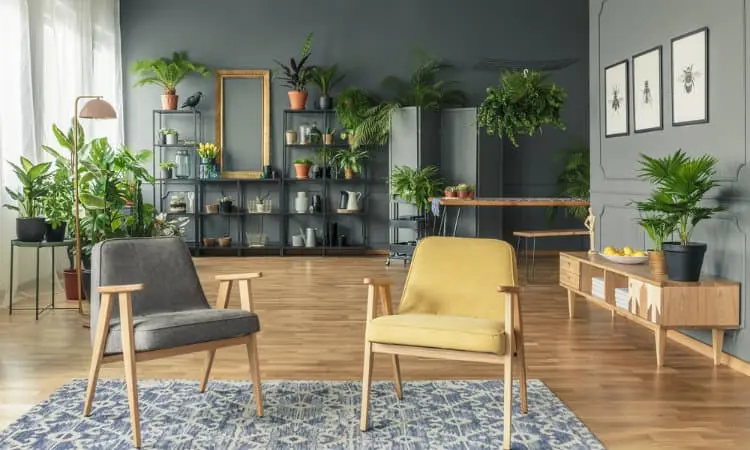
You may be wondering exactly how plants are able to dampen sound so effectively. There are a few key mechanisms at work that enable houseplants to absorb noise pollution:
Deflection of Sound Waves by Plants
The first way that leafy green plants reduce noise is by physically deflecting sound waves instead of reflecting them. Their foliage and branches catch sounds and scatter them rather than bouncing them off hard walls and surfaces. This diffusion helps prevent echoes and reverberation from building up.
Trapping and Absorption of Sound by Plant Features
In addition to deflection, plants also trap sound vibrations within their leaves, branches, soil, and potting materials. The complex physical structure of plants enables them to absorb noises rather than amplifying them. Trapped sound gets broken down and dissipated by plants.
Experiment and Evidence of Sound Reduction by Indoor Plants
Several scientific studies have demonstrated the measurable sound-absorbing capabilities of indoor plants:
- A study published in the Journal of Physiology and Behavior found that participants perceived rooms with plants as quieter than identical bare rooms. Sound recordings confirmed a measurable reduction in ambient noise levels.
- Researchers in the Netherlands experimented with various indoor plant arrangements and found optimal noise absorption with dense rows of bushy, leafy plants spaced close together.
- Another Dutch study tested different species and revealed that large-leafed tropical plants absorbed the most sound due to their complex branch and leaf structures.
- An analysis by Washington State University researchers concluded that adding plants to rooms can reduce overall decibel levels, with more significant reductions at higher frequencies.
So modern acoustic science confirms what may have first seemed improbable – plants really do absorb and block noise!
Conclusion
Indoor plants have so much to offer inside our homes and workplaces, including their notable ability to absorb unwanted noise. Certain large-leaved varieties with bushy foliage are particularly adept acoustic absorbers. Strategically clustering them can make a real difference in sound reduction.
The next time you’re looking to dampen bothersome echoes or muffle excessive noise levels, consider adding one of these top sound-absorbing plants. Their natural sound barriers will help create a more relaxing, peaceful interior space.
So explore the wonderful world of noise-reducing indoor plants! Filling your rooms with their lush green foliage, intriguing textures, and sweet scents is a win-win for both aesthetic and acoustic comfort.

